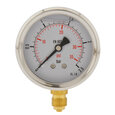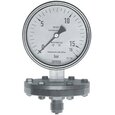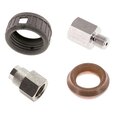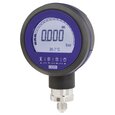Why Does Water Pressure Drop
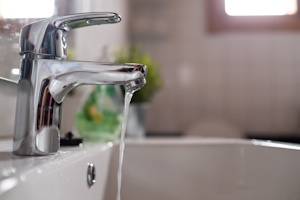
Figure 1: Faucet with low water pressure.
Water pressure drop, a phenomenon commonly experienced in residential and industrial settings, significantly reduces the force pushing water through the pipelines. This can be attributed to various reasons, such as pipe leakage, blockages, or high peak demand. Identifying and troubleshooting these issues promptly is crucial, as the consistent low water pressure can lead to inefficient water usage and disrupt day-to-day activities or industrial processes. This article explores the main causes and fixes for water pressure drop.
Table of contents
- Water pressure and its significance
- Water pressure drop in appliances
- Causes
- Testing and common fixes
- FAQs
View our online selection of pressure gauges!
Water pressure and its significance
Water pressure refers to the force exerted by water against the walls of a conduit (pipe) as it flows. Large reservoir tanks are positioned at a higher altitude in water distribution systems than the buildings that need water. The water system uses gravity to raise the water pressure, and most cities and towns also use pressure stations and pumps to increase the pressure to a suitable level. Read our gravity-fed water system article for more details.
Water pressure at home
The ideal water pressure range for most houses is 2.76 - 4.1 bar (40 - 60 psi), although it can vary more to be between 2 and 5.5 bar (30 - 80 psi). Maintaining the optimum water pressure is crucial. If relying on city water, the control over water pressure is limited. The city water system controls the pressure and can fluctuate based on demand, maintenance issues, and other similar factors. High water pressure can damage plumbing fixtures, appliances, and pipes, resulting in expensive repairs. On the other hand, low water pressure can affect the performance of devices like dishwashers and clothes washers, resulting in a less satisfying shower experience.
Water pressure drop in appliances
A water pressure drop is a noticeable decrease in the force that pushes water through the pipes. Normally, this pressure is quite steady, but sometimes, it can fluctuate for various reasons (discussed later).
A drop in water pressure is typically observed when multiple appliances or water outlets are used simultaneously to draw from the same water supply. This sudden increased demand can temporarily drop water pressure as the supply is divided among the different appliances.
- Washing machine: A running washing machine uses a significant amount of water, causing a drop in water pressure in other parts of the house.
- Toilet: Flushing a toilet can temporarily decrease water pressure as the toilet's tank refills.
- Shower: Taking a shower can lead to a drop in water pressure, especially if other water-consuming appliances are being used simultaneously. Also, when more than one faucet is on, the water supply is divided among them, leading to a drop in water pressure.
- Sprinklers: Sprinklers for gardening or lawn care can cause a noticeable drop in water pressure, as they often require a large volume of water.
Causes
There are several other reasons a house might experience a decrease in water pressure, either suddenly or over a prolonged period.
- Water main break: One of the main causes of water pressure drop is obstruction by partially closed valves. Generally, a house has a single main water shutoff valve. A sudden drop in water pressure throughout the house signifies a break in the main water supply.
- Well failure: A malfunctioning well pump can cause a water pressure drop in a building. This can be due to a tripped breaker or a failed motor.
- Partially closed main valve: If the water pressure is low around the entire house, but water is still flowing, the main valve might be slightly closed. This valve regulates the water flow from the well or city and is usually inside the house where the main line enters. These valves can be turned off accidentally or even fail to operate.
- Malfunctioning pressure regulator: A pressure regulator is usually installed on the main water line to prevent the pressure from rising too high. The regulator could be set too low or clogged with debris over time.
- Hydrant flushing: City water companies regularly flush hydrants to ensure they are functioning correctly and not blocked by debris. This process uses a lot of water, which can cause a temporary drop in water pressure for connected homes.
- Leaks: A water pressure lower than usual can be due to leaks. Leaks commonly occur around hoses, water heaters, and valves under sinks.
- Role of distance: As water travels through pipes, it faces resistance, leading to pressure loss. The farther the water has to travel, the more resistance it encounters, leading to a greater drop. Water pressure can decrease for every 100 ft (30.5 m) of distance due to the gravitational pull and resistance within the pipes. A general rule of thumb is that the water pressure drops by 0.433 psi for every foot of pipe, so for every 100 feet, it would drop by approximately 43.3 PSI (3 bar). But, this is a rough estimate, and actual values can vary.
- Clogged screen in the shower head: Sink aerators and shower head fixtures have small screens that collect debris while dispersing water evenly. If substantial sediment is in the water, these screens can become fully blocked, causing the water pressure to drop significantly.
- Water heater issue: If the water pressure drops only when using hot water, the problem might be with the water heater. The water heater might leak or be clogged with sediment, or the valves may not be opening completely.
Testing and common fixes
A sudden drop in water pressure can be diagnosed with the following tips:
- A sudden pressure drop in a single tap means the tap may be faulty.
- A rapid low pressure affecting a particular house section suggests a corroded pipe.
- A sudden drop in water pressure affecting the entire house signifies a break in the main water supply (if using municipal water) or a well pump issue (if using well).
Testing water pressure
Use a pressure gauge to test the water pressure at home.
- Ensure all faucets and appliances using water are turned off.
- Connect the water pressure gauge to the exterior hose bib or hose faucet.
- Turn the faucet on completely and read the gauge to determine the water pressure.
Fixes
Resolving low water pressure can either be straightforward and affordable or complicated and expensive. Here are some common methods to rectify low water pressure.
- Contact the city authorities: If there's a break in the main water supply, hydrant flushing, or the system has been shut down for repairs, it's necessary to contact the city authorities to determine the problem.
-
Open or replace valves:
- Check for partially closed valves and open them completely. This allows more water to flow through the valve, increasing the pressure at the sink, shower, or toilet. Before opening a completely closed valve, it's crucial to understand its function to avoid flooding and damaging the house.
- If a valve is leaking or broken, it should be repaired promptly. Although this valve may limit flow, it could block the entire system if its internal parts are dislodged.
- When it comes to toilet fill valves, it's more practical to replace them rather than clean them. They are simple to handle and economical enough that cleaning often isn't worth the effort. Read our articles on ball valve maintenance and troubleshooting ball valve leaks for more information on dealing with valve issues.
-
Clean aerators and screens: Cleaning the screens inside the shower heads and sink aerators improves the water pressure.
- Unscrew the aerator from the shower head, use a pick to remove the rubber washer, and empty the screen onto a paper towel.
- Use a brush to clear debris on the mesh and reassemble the structure.
- Adjust the regulator: A water pressure regulator has a diaphragm that can be adjusted using a bolt. Turning the bolt clockwise will increase water pressure, while turning it counterclockwise will reduce the pressure.
- Repair leaks: Leaks in pipes should be fixed immediately. Leaks reduce water pressure and can lead to mold and pest issues. Check appliances, hoses, valves, and other fixtures for leaks.
Read our off-grid elevated water system design article for more information on the layout and working of an off-grid gravity-assisted water system for a cabin.
FAQs
What causes water pressure to drop?
Water pressure can drop due to several factors, like multiple appliances using water simultaneously, plumbing issues, or the distance water travels.
Why does the well water pressure drop and then come back?
It may be due to a malfunctioning pressure switch or issues with the pressure tank. It could also be due to blockages in the plumbing system that eventually clear up, restoring the pressure.
Why does water pressure drop when more than one faucet is on?
When more than one faucet is open, the same amount of water is split between multiple outlets, leading to a drop in water pressure at each faucet.




